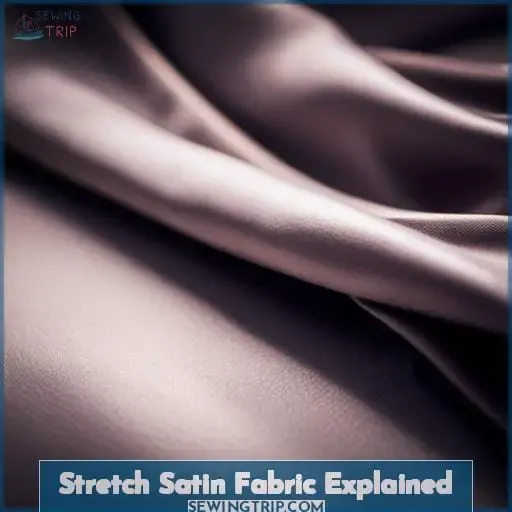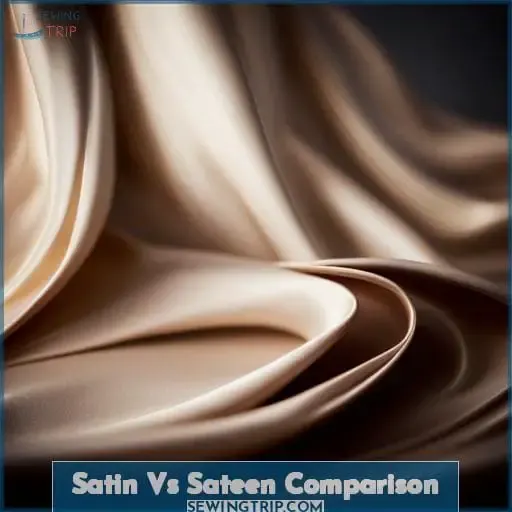This site is supported by our readers. We may earn a commission, at no cost to you, if you purchase through links.
 Like a cat stretching out in the sun, satin has a limited ability to stretch, making it a desirable fabric for clothing and accessories.
Like a cat stretching out in the sun, satin has a limited ability to stretch, making it a desirable fabric for clothing and accessories.
Whether you have a pair of satin shoes that feel too tight or a dress that’s a bit snug, there are several techniques you can try to safely widen satin without damaging the fabric.
From using shoe stretchers to stuffing techniques, we’ll explore the best methods for stretching satin so you can enjoy your satin garments with comfort and confidence.
Table Of Contents
- Key Takeaways
- Is Pure Satin Stretchy?
- Stretch Satin Fabric Explained
- What is Twill Satin Weave?
- Stretching Satin Shoes Safely
- Making Satin Shoes Wider
- Stretching Ballet Slippers
- Can You Stretch a Satin Dress?
- Characteristics of Satin Fabric
- Satin Vs Sateen Comparison
- Satin Fabric Care Tips
- Frequently Asked Questions (FAQs)
- Conclusion
Key Takeaways
- Use shoe stretchers, stuffing, freezing to gently expand tight satin shoes.
- Insert padding in areas that need stretching for custom ballet slipper fit.
- Have a professional seamstress carefully let out or take in key seams on satin dresses.
- Handle, fold, iron, and store satin properly to avoid damage and creasing.
Is Pure Satin Stretchy?
When selecting your satin fabric, remember that pure satin offers little to no stretch.
The smooth, glossy finish makes satin a popular choice, but its delicate structure limits elasticity.
Blending satin with a stretch material like spandex yields better stretchability.
Polyester-spandex blends maintain satin’s luxurious aesthetic while allowing the fabric to flex.
These blends offer around 15% stretch—enough ease for an elegant evening gown.
For super stretchy satin, go with a blend using at least 3% spandex fibers.
If your outfit requires significant stretch capacity, pure satin may not suffice.
Its smooth, slippery texture simply can’t expand much without distortion.
However, small amounts of spandex transform satin into a stretchier incarnation, striking the perfect balance between flexibility and opulence.
By understanding satin’s limitations and seeking stretchier alternatives, you can craft form-fitting designs or find the perfect ready-to-wear piece.
With smart blending and fabric selection, satin’s princess-like drama endures while gaining mobility.
Stretch Satin Fabric Explained
Let us move forward from whether pure satin is stretchy to understanding stretch satin fabric.
Now, while pure satin focuses on beauty over flexibility, you can blend it with spandex to create the stretch you crave.
Incorporating just 3% spandex achieves an adequate stretch through an exquisite polyester-spandex intermingling.
This stretch satin oozes the glamour of traditional satin while hugging your shape in all the right places.
Its eye-catching sheen and sultry drape flatter feminine silhouettes, making it ideal for evening gowns, special occasion wear, and wedding dresses.
Yet the subtle stretch empowers you, allowing effortless movement as you dance the night away.
With stretch satin’s princess-like splendor meets modern mobility, you can command every room with class and comfort.
What is Twill Satin Weave?
You’ll notice twilled satin has some stretch capacity, although it’s still considered quite low.
Since the twill weaving style can restrict stretching across the diagonal textile pattern.
Twill is a distinct weaving pattern, not a specific type of fabric.
The diagonal interlacing makes stretching more difficult.
Twill weave involves 8 steps and is seen in fabrics like denim.
While twilled satin may have a smidgeon of give, its stretch potential remains quite minimal overall.
This is due to the tightly woven diagonal arrangement of threads, which form the signature twill visual.
Just a friendly reminder as we explore the coveted world of satins!
Stretching Satin Shoes Safely
Carefulness enables you to stretch satin shoes without damaging them when using solutions or shoe stretchers.
Applying a leather conditioner or freezing the shoes can help them stretch, but overdoing these techniques risks harming the satin.
Similarly, stuffing shoes with newspaper should be done gradually.
As you evaluate stretching approaches, remember that higher quality satin resists expanding more than lower quality fabrics.
Frequent wearing naturally stretches most shoes over time through conforming to your feet’s shape.
For immediate stretching, specialized services professionally widen shoes.
However you proceed, monitor for ripped seams or distorted dimensions.
Ultimately, well-cared for satin shoes, with their smooth, princess-like aesthetic, stretch more than leather while retaining their elegance.
Proper maintenance like shoe trees, protective sprays, and avoiding moisture preserves these delicate shoes as you gently stretch them.
| Method | Caution |
|---|---|
| Leather Conditioner | Don’t Oversoften |
| Freezing | Don’t Crack Material |
| Newspaper Stuffing | Go Slowly |
Making Satin Shoes Wider
When your satin heels start to feel a bit snug, you have options to gently stretch them wider.
Shoe stretchers specially designed for satins can steadily widen the shoe without damage.
You can also lightly stuff the toes with tissue paper overnight to carefully ease the satin.
Shoe Stretchers
Using a shoe stretcher is one effective way to safely widen your satin shoes without distorting their shape.
Slowly turn the stretcher’s key to gently expand the stretcher inside your shoes. This allows them to incrementally stretch wider while retaining their structure.
However, take care not to over-stretch delicate satins.
Consider a shoe stretcher if your satins feel too snug, but stop expanding them once they reach the desired roomy fit.
Stuffing techniques combined with moderate stretcher use can help widen satin shoes without damage.
Stuffing Techniques
Through stuffing, you’re able to stretch satin shoes gradually without damaging the delicate material.
Here are some tips for using stuffing techniques to make your satin shoes wider:
- Start by inserting a soft cloth or padding into the toe area of the shoe.
- Gently stuff additional padding around the sides and back of the shoe.
- Use tissue paper or cotton balls to fill any gaps and create an even stretch.
- Leave the st■ shoes overnight or for several days to allow them time to expand.
Stretching Ballet Slippers
Stretch your ballet slippers slowly over several wears to widen them for a custom fit.
New satin slippers are snug, requiring breaking in. Each wear gently molds and shapes the satin to your foot’s dimensions.
Don’t force a drastic stretch right away or the seams may tear. With patience, your slippers will shape to your feet.
Try wearing slippers for short periods at first, removing when discomfort arises.
Stuff toes lightly with cotton balls for a slight stretch. For width, insert foam pads across the ball of your foot.
Let slippers dry fully between each wear.
By respecting satin’s limits, you’ll lengthen your slipper’s life and prevent injury. Proper stretching eases pain while transforming stiff satin into a custom second skin.
Can You Stretch a Satin Dress?
When your satin dress feels too snug, resist the urge to over-stretch the fabric.
Better solutions are:
- Using shapewear like Spanx
- Having a professional seamstress tactfully let out key seams.
Damaging the dress’s sleek satin risks distorting the fabric’s smooth, elegant drape.
Spanx Solutions
You’re able to smoothly shape your tight satin dress with Spanx.
Spanx can help create a smoother look under a tight dress by reducing the appearance of bulges and bumps.
Spanx is a versatile shapewear option that can be worn under any type of dress.
If the satin dress is still too tight with Spanx, consider having a seamstress professionally adjust the seams.
An experienced seamstress may be able to let out certain seams to provide a better fit.
These alternatives can help you achieve your desired look without overstretching delicate satin fabric.
Seam Adjustments
Your seamstress can let out seams on your satin dress to provide a better fit if Spanx alone doesn’t give you enough room:
- Take in the side seams to contour the waist.
- Let out the shoulder seams for better arm movement.
- Adjust the hemline for better length.
- Open the back seam to expand the waist and bust.
Characteristics of Satin Fabric
Satin’s smoothness comes from its tightly-woven threads and distinctive finish.
The weave creates a glossy surface on one side with a duller matte finish on the other.
Pure satin doesn’t have inherent stretch, but it can be blended with spandex or other stretchy fibers to create a fabric with some give.
While satin has a fluid drape, it doesn’t bounce back readily when stretched.
That’s why care should be taken when fitting satin garments and shoes.
Maintaining their structure prolongs their beauty.
With proper care, high-quality satin keeps its luxurious look.
So relish the sensuous glide of this fabric against your skin, but avoid over-stretching.
Satin rewards those who cherish its delicate nature.
Satin Vs Sateen Comparison
You’ve just compared satin’s characteristics, now let’s contrast satin and sateen fabrics.
While often confused, satin and sateen have distinct differences:
- Satin has a glossy surface and dull underside, while sateen has a subtle sheen on both sides.
- Satin’s weave patterns tend to be more pronounced. Sateen is known for its smooth, uniform appearance.
- Satin drapes well but resists stretching. Sateen has slightly more give.
- For shoe care, satin shows scuffs readily. Sateen is more durable and stain-resistant.
- Certain qualities like luster vary by the type of fiber used in each fabric.
Know the nuances as you select your luxurious fabrics. With smart choices, your designs will dazzle.
Satin Fabric Care Tips
You can keep your satin looking pristine by following these care tips:
- Handle satin gently to avoid snags.
- Always fold satin properly along seams and avoid creasing.
- Store flat if possible.
- Use a steam iron on a low setting, test on an inconspicuous area first.
- Avoid pressure to prevent shine loss.
- Cover with a press cloth.
- Dry clean satin only when necessary.
- Spot clean gently with a mild detergent, cold water, and soft cloth.
- Avoid scrubbing.
- To remove wrinkles, hang satin in a steamy bathroom.
- The moisture should relax the fibers.
- You can also use a garment steamer.
- For stains, blot immediately.
- Use distilled vinegar for water-based stains, rubbing alcohol for oil-based.
- Test first.
- Keep satin covered in breathable fabric when storing.
- Avoid plastic that traps moisture.
- Store in cool, dark places.
Frequently Asked Questions (FAQs)
How much can you stretch satin before it tears?
As a sewing instructor, my advice is:
- Don’t overstretch satin.
- It can distort seams and make them pop before it tears.
- Opt for spandex blends or professional alterations for the best fit.
Satin shows every ripple, so take care.
You’ll look your best without ruining the dress.
Is it better to stretch satin width-wise or length-wise?
Width-wise for less strain.
Length pulls seams taut.
Across gives gentle ease.
Let out side seams incrementally.
Breathe and move freely again.
What home remedies can help stretch tight satin shoes?
Wear thick socks while walking in the shoes to help mold them to your feet.
To stretch them further, stuff the toes with newspaper overnight or gently use a shoe stretcher.
Avoid overstretching the satin, or you could warp the shape.
How do you soften stiff new satin shoes?
Apply leather conditioner inside each shoe.
Stuff with socks.
Wear thick socks and walk around your home.
The friction and pressure will soften the stiff satin.
Let shoes rest st■ overnight to hold their new shape.
What is the maximum percentage of spandex you can blend with satin before compromising its signature sheen?
Up to 5% spandex can be blended with satin to add stretch without compromising the signature sheen.
Any more and you risk dulling the fabric’s lustrous finish.
Keep the spandex low to maintain satin’s elegant drape.
Conclusion
Like a dancer stretching before a show, you too must warm up satin with care to avoid runs and tears.
Slowly widen your silky shoes with stuffing or stretchers.
Let out snug seams in dresses bit by bit.
With patience, your satin will gently give and shape itself to you.
Treat it well and it will become an old friend, hugging your curves comfortably for years to come.
Just go slow and avoid overstretching, for even the most fluid fabrics have their limits.
















